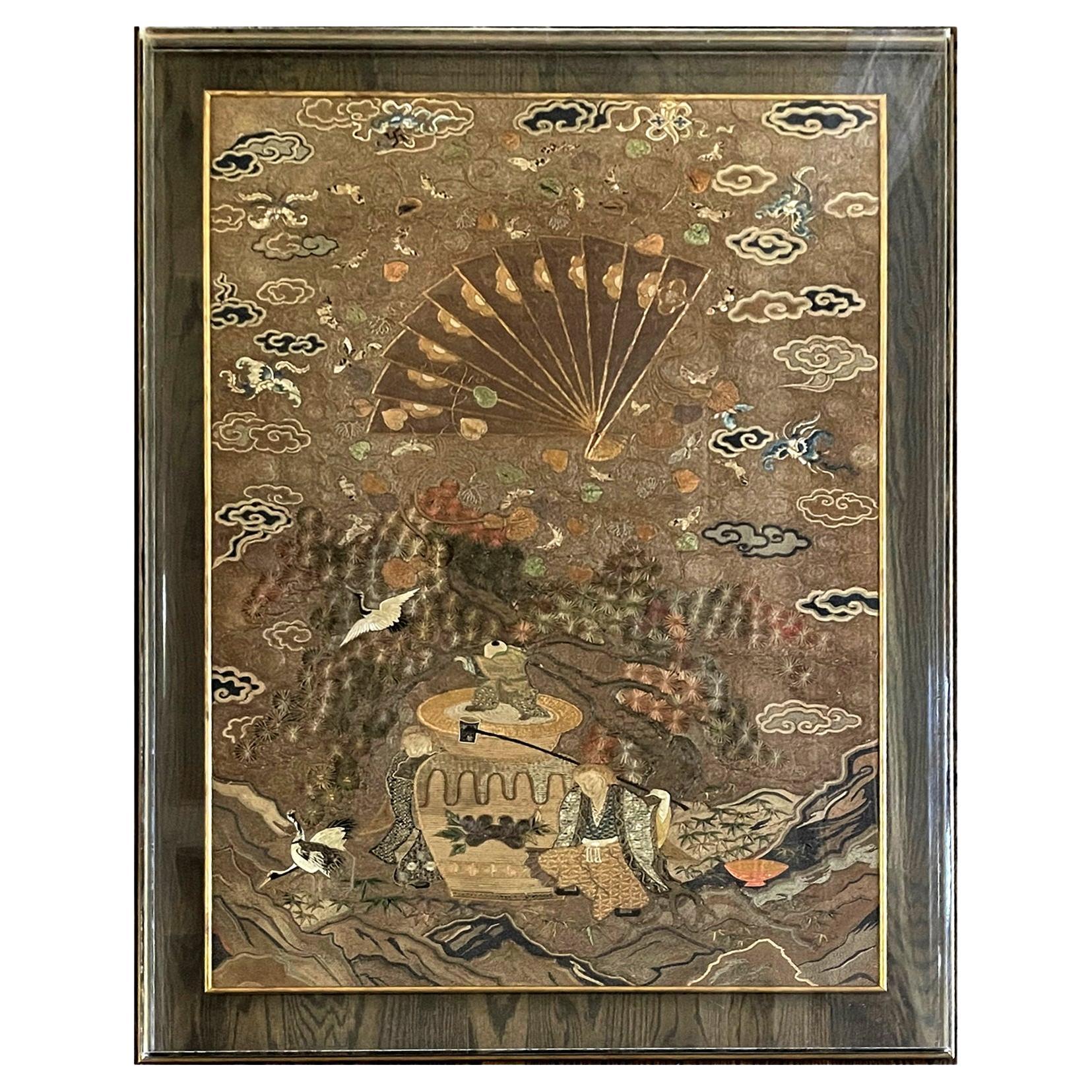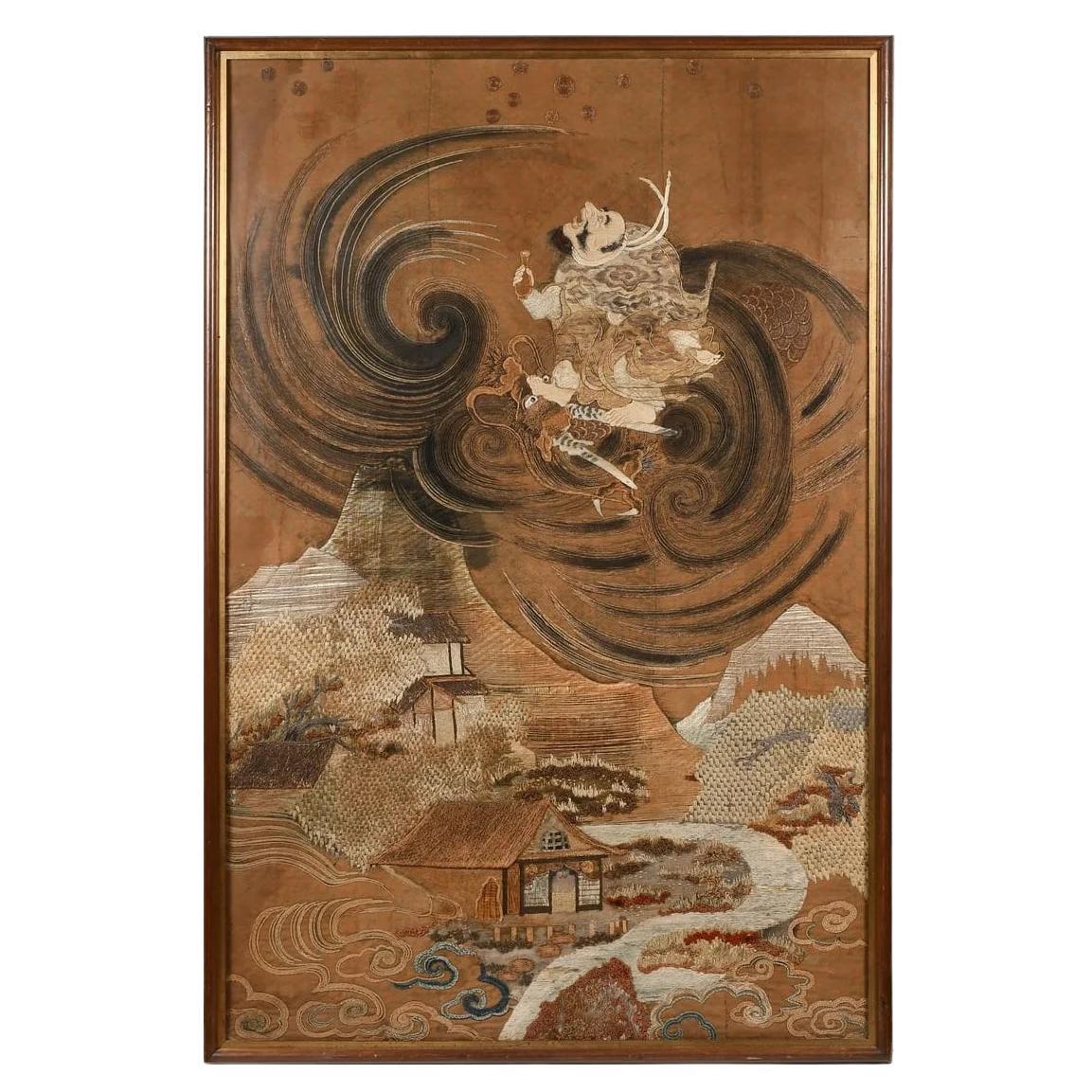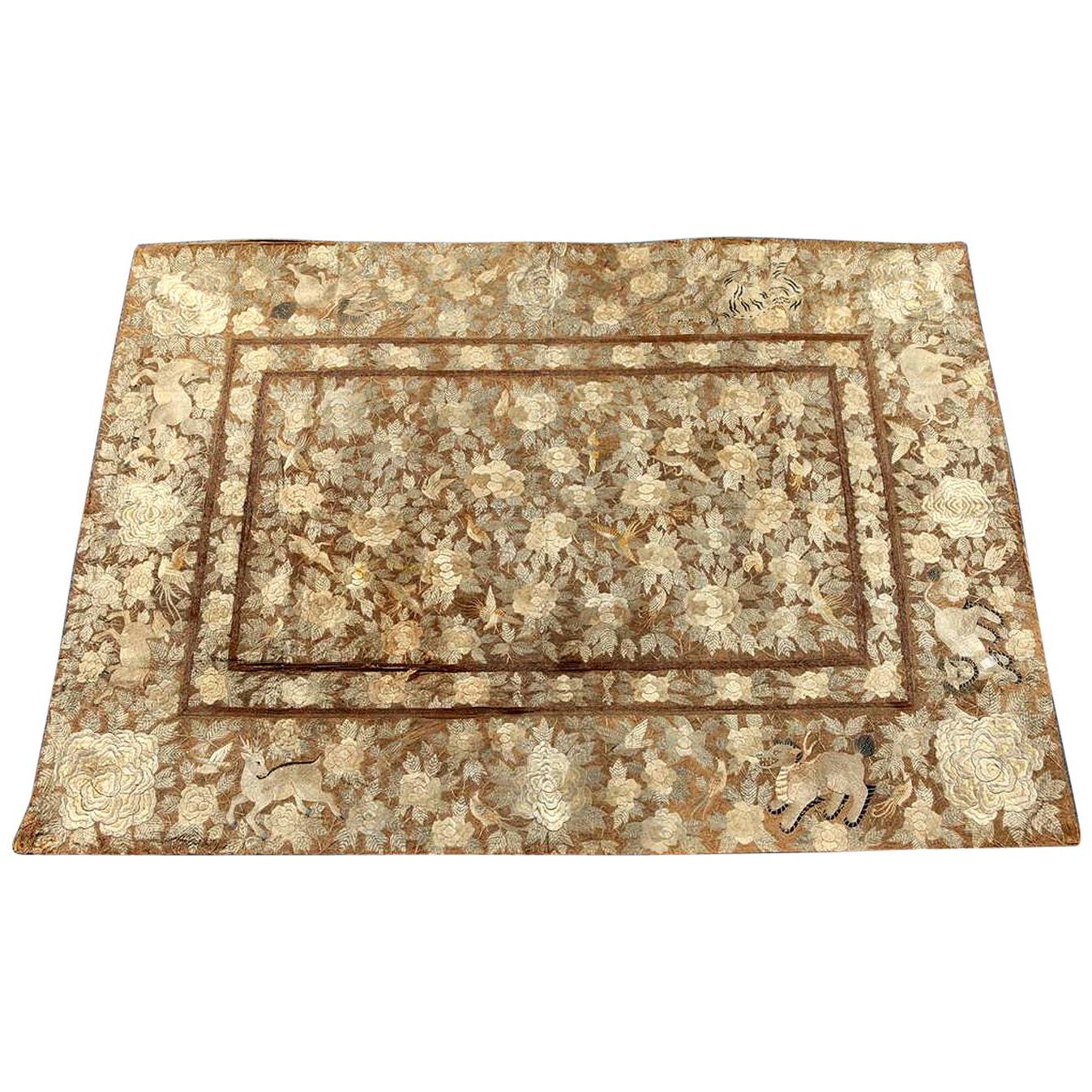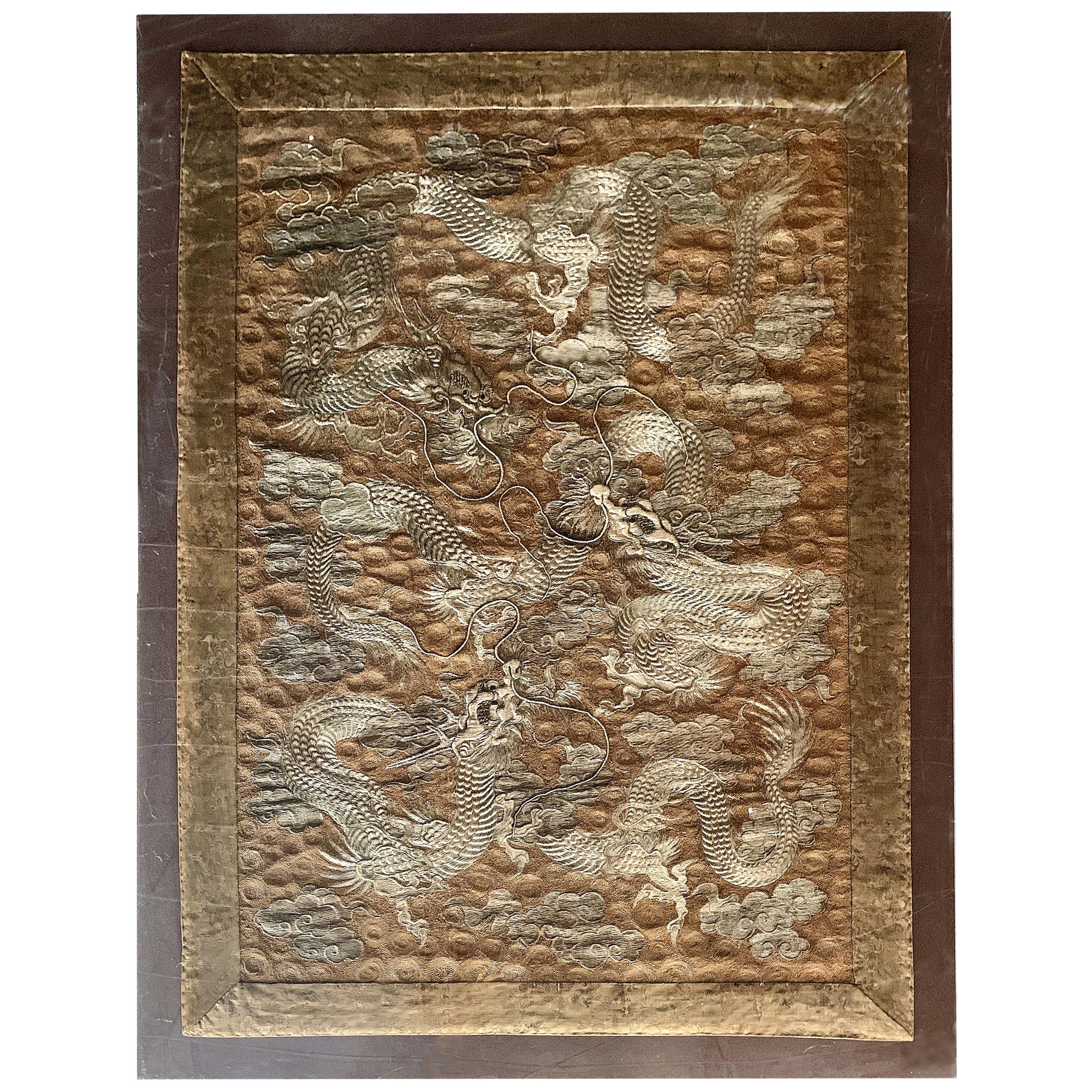Items Similar to Massive Japanese Embroidery Tapestry Display Box Meiji Period
Want more images or videos?
Request additional images or videos from the seller
1 of 21
Massive Japanese Embroidery Tapestry Display Box Meiji Period
About the Item
A massive Japanese embordered tapestry professionally displayed in a custom acrylic shadow box. The fine work of textile art is dated to 1890-1920s, late Meiji (1868-1912) or possibly Taisho (1912-1926) era.
Presented with brocade border on linen canvas and finely worked in colored silk and metallic threads, the design features a mythical scene with two of the most beloved creatures in Japanese culture. On the upper part, it showcases a rising phoenix in flight with fully spread wings among swirling clouds. Below the auspicious bird, a kirin with impressive golden furs looks up on a rocky shore, all on a greenish-grey ground arrayed with white clouds.
The piece is a tour-de-force work of art. The high relief technique using a combination of gold and silver threads with different sheen and shades renders the piece a tremendous sense of dimension. Its impressive size, the superb craftsmanship and near perfect condition set it apart. Japanese Meiji textiles were widely exhibited in the west during turn of the 20th century at the international exposition. It was used to showcase the Japanese aesthetics with the techniques at their pinnacle. These expositions solidified the country's images overseas and fueled the Japanese craze in the west, which turned out to be a long-lasting influence on the western art. Many pieces were purchased and stayed in the west. It is most likely this estate piece was from one of the expositions based on its high quality and well-preserved condition.
For two similar tapestries featuring Pheonix and Kirin see the example in "Threads of silk and gold ornamental textile from Meiji Japan Ashmolean", figure 5 and 6 on page 94-95.
Re-envisioning Japan Meiji Fine Art Textile, John E. Vollmer, Illustration on page 181.
For detailed terminology of embroidery techniques used in this work, please refer to threads of silk and gold ornamental textile from Meiji Japan Ashmolean page 86-87.
- Dimensions:Height: 97 in (246.38 cm)Width: 66 in (167.64 cm)Depth: 1.8 in (4.58 cm)
- Style:Japonisme (Of the Period)
- Materials and Techniques:
- Place of Origin:
- Period:
- Date of Manufacture:1890s-1920s
- Condition:Wear consistent with age and use. Fine antique textile condition, framed in an acrylic shadow box, expected slight surface wear and minor fabric folding mark and undulation due to the nature of the materials.
- Seller Location:Atlanta, GA
- Reference Number:1stDibs: LU945027233882
About the Seller
5.0
Platinum Seller
These expertly vetted sellers are 1stDibs' most experienced sellers and are rated highest by our customers.
Established in 2006
1stDibs seller since 2010
480 sales on 1stDibs
Typical response time: <1 hour
- ShippingRetrieving quote...Ships From: Atlanta, GA
- Return PolicyThis item cannot be returned.
More From This SellerView All
- Large Japanese Embroidery Tapestry Meiji PeriodLocated in Atlanta, GAA large and finely embroidered Japanese tapestry with brocade border, circa 1900s Meiji period. The tapestry depicts, in a rather realistic style, a forested landscape in autumn flan...Category
Early 20th Century Japanese Japonisme Textiles
MaterialsBrocade, Silk
- Japanese Silk Embroidery Tapestry Meiji PeriodLocated in Atlanta, GAA spectacular Japanese embroidered silk panel beautifully presented in a gilt frame suspended in a lucite shadow box with gilt wood border. The silk picture is dated to 1890-1910s toward the end of Meiji Period, when Japanese started to participate international expose by presenting its best art and craft. Elaborate embroidered silk tapestry like this was very popular among westerners due to its superb craftmanship and also exotic subject matter that was often derived from classic Japanese folklore, mythology and various motifs. The tapestry on offer is such an example. It depicts an old couple...Category
Antique 1890s Japanese Japonisme Textiles
MaterialsFabric, Silk, Lucite
- Framed Japanese Antique Phoenix Dragon Embroidery Tapestry Meiji PeriodLocated in Atlanta, GAA visually stunning Japanese embroidery tapestry circa 1890s-1900s late Meiji period, presented with a linen matt with gold trim in a gilt wood frame. The design showcases a flying p...Category
Antique 1890s Japanese Japonisme Textiles
MaterialsSilk, Giltwood
- Framed Japanese Antique Embroidery Sennin Tapestry Meiji PeriodLocated in Atlanta, GAA stunning Japanese embroidery tapestry circa 1880s-1900s from late Meiji period, presented with an original wood frame with inner gold trim. The tour-de-force embroidered tapestry s...Category
Antique 1890s Japanese Meiji Textiles
MaterialsGiltwood, Silk
- Antique Japanese Embroidery TapestryLocated in Atlanta, GAA large Japanese silk embroidery tapestry circa 19th century, late Edo to early Meiji period. Meticulously handwork that densely depicts repea...Category
Antique 19th Century Japanese Japonisme Textiles
MaterialsSilk
- Large Framed Japanese Embroidery Dragon TapestryLocated in Atlanta, GAAn impressive Japanese embroidery tapestry circa 1890s Meiji period, presented with brocade border on linen canvas in a Lucite shadow box. The stunning design features three dragons coiling and flying in the clouds. The high relief technique used to render the dragons using mostly the silver threads gives this piece a tremendous sense of motion. The most auspicious mythological creature in Japan and China, dragons were a very popular motif in textile art. In this particular piece, it is the impressive size, the superb craftsmanship, the profuse use of silver threads and near perfect condition that set it apart. Japanese Meiji textiles were widely exhibited in the west during turn of the 20th century at the international exposition. It was used to showcase the Japanese aesthetics with the techniques at their pinnacle. These expositions solidified the country's images overseas and felled the Japanese craze in the west, which turned out to be a long-lasting influence on the western art. Many pieces were purchased and stayed in the west. It is likely this estate piece was from one of the expositions based on its high quality. For two similar dragon tapestries...Category
Antique 1890s Japanese Japonisme Textiles
MaterialsTextile, Lucite
You May Also Like
- Late Meiji Period Sleeping Kimono / Yogi, JapanLocated in Point Richmond, CALate Meiji Period sleeping Kimono / Yogi, Japan Yogi are a type of oversized sleeping kimono traditionally used in Japan. This kimono would have b...Category
Early 20th Century Japanese Tribal Textiles
MaterialsCotton
- Meiji Period Japanese Indigo Double Ikat Futon CoverLocated in Point Richmond, CAMeiji period Japanese Indigo double ikat futon cover Japanese futon cover, a double ikat pattern in four panels depicting Kumamoto Castle with im...Category
Antique 1890s Japanese Meiji Textiles
MaterialsCotton
- Susani Uzbek Embroidery TapestryLocated in Alessandria, PiemonteOld very elegant "susani" from Uzbekistan - not too large, it's perfect for wall like a picture or a tapestry; else placed on a table or on the back of a sofa. ref. B/2433.Category
21st Century and Contemporary Uzbek Other Textiles
MaterialsSilk
- Japanese Indigo Dyed Old Embroidery Cloth / Japanese Toy Pattern / 1912-1960Located in Sammu-shi, ChibaIt is a Japanese indigo dyed antique cloth. It calls its name "fu-ro-shi-ki". Originally used in the dressing room of the public bath "furo" during the...Category
Early 20th Century Japanese Showa Textiles
MaterialsCotton
- "BORO" / Japanese Old Cloth / Tapestry / Wall DecorationLocated in Sammu-shi, ChibaWe have a unique Japanese sense of beauty. We will also introduce unique items that only we can make, purchasing routes in Japan, experience gained so far, and methods that no one el...Category
Early 20th Century Japanese Showa Textiles
MaterialsCotton, Linen
- "BORO" / Japanese Old Cloth / Tapestry / Wall DecorationLocated in Sammu-shi, ChibaWe have a unique Japanese sense of beauty. We will also introduce unique items that only we can make, purchasing routes in Japan, experience gained so far, and methods that no one el...Category
Early 20th Century Japanese Showa Textiles
MaterialsCotton, Linen
Recently Viewed
View AllMore Ways To Browse
Silk And Gold
Showcase Display Used
Custom Display
Long Textiles
Textile Gold
Embroidery Textile
Display Boxes
Display Box
Century Display Showcase
Japanese Textile
Japan Textiles
Antique Linens And Textiles
Antique Textiles Linens And Textiles
Display Showcase
Antique Display Box
Japanese Influence Furniture
Antique Display Showcases
Antique Display Showcase





